The Meridian of the Cathedral of Milan
 |
The coordinates
of the Basilica are: 41° 54' 11'' N, and 12° 29' 51'' E |
  |
Height of the gnomon hole. |
 |
The year is
2009. |
 |
Use the keys "y", "m",
or "d" to increase the year, month, or day, or shift key and "y", "m", or "d" to decrease the year, month, or day. |
  |
Use the command key and
"u" or "d" to move up or down. Use "Reset" from the Details menu to reset the position and zoom. |
 |
Select "Write Data" or "Write Table" from the Details menu to open data windows. |
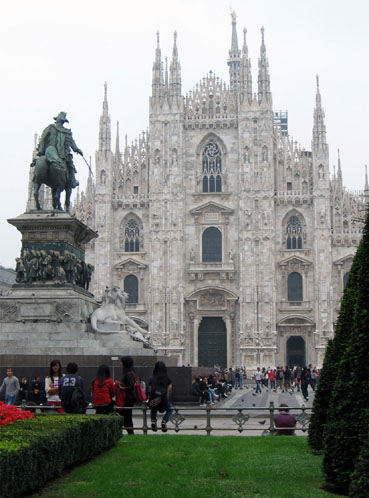 Milan
Cathedral (Duomo di Milano) as seen from the square.
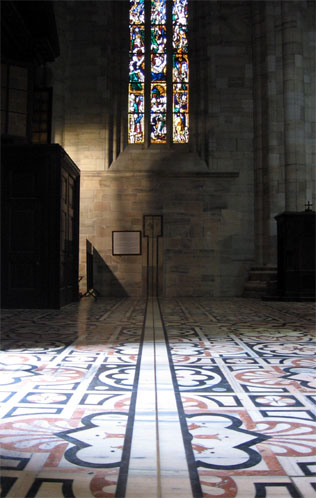 The solar meridian line near the main entrance of the cathedral. The sun shines through a small hole in the southern wall to cast its light on the meridian line each day (aperture gnomon). The length of the meridian line is limited by the northern wall (at d=55.01 m). 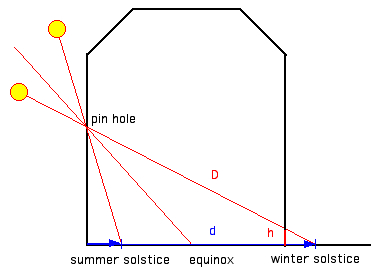 The aperture gnomon. The mean transit time (solar noon) is 11:23 UT, which varies according to the equation of time from around 11:00 UT to 11:37 UT. The distance d of the disk of light along the meridian line and the size (horizontal and vertical) are increasing from summer solstice to winter solstice, whereas the time t to cross the meridian line remains nearly constant. 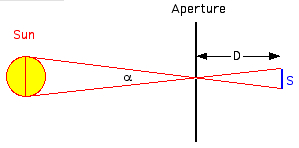 The diameter S of the
disk of light is mainly determined by the apparent
diameter α of the Sun:
S = D·tan α
The
duration t (in seconds) of the meridian transit
depends on the Sun's diameter α (arc
seconds) and the declination δ:
 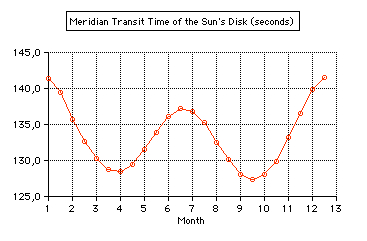 The diameter
a of the aperture and an amount due to diffraction (2·D·1.22·λ/a ≈4 mm) has to be added to S.
The diameter of the aperture is 7 mm The image is
of greatest sharpness if the distance D from the
aperture (diameter a) to the surface is given) by
(wavelength λ):
 D = 22.3 m (for a=7 mm, λ=550 nm) In Europe
the Julian calendar was in use since the 4th
century. The spring equinox was set to the date 21
March in the year 325 by the council of Nicea. By
the year 1582, the spring equinox was occurring on
March 11.
Pope Gregory XIII ordered that 10 days would be removed from the calendar so that the spring equinox would return to March 21. It was decided that the days October 5-14 of the year 1582 would be skipped during the transformation from the Julian to Gregorian calendar. is 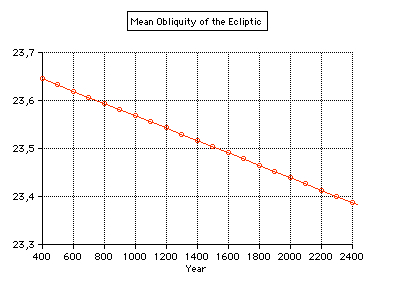 In the past centuries
the obliquity of the ecliptic decreased by 0.013° per
century. The result is a shift of the sun spot on the
meridian line:
|
|
|
|
Santa Maria degli
Angeli e dei Martiri (Wikipedia) S. Maria degli
Angeli e dei Martiri: La Meridiana
|
| Books |
| Carlo Ferrari
da Passano, Carlo Monti, Luigi Mussio: La meridiana
solare del Duomo di Milano, Veneranda Fabbrica del
Duomo di Milano, 2001 J. L. Heilbron: The Sun in the Cathedral, Cathedrals as Solar Observatories, Harvard University Press, 1999. Frans and Margret Bruin: The Limits of Accuracy of Aperture-Gnomons, in: Y. Maeyama and W. G. Saltzer (Editors): Primata, Naturwissenschaftliche Studien, Steiner, Wiesbaden 1977, pp.21-42. |

Updated: 2023, Oct 06

